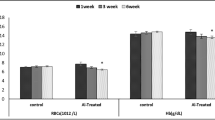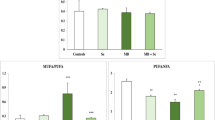Abstract
The effect of various doses of sodium tellurite (1/50 LD50=0.4 mg/kg, 1/25 LD50=0.8 mg/kg, and 1/10 LD50=2.0 mg/kg body weight orally) on the lipid levels (cholesterol, triglycerides, phospholipids, esterified fatty acids, gangliosides, and total lipids) in the cerebrum, cerebellum, and brainstem of male albino mice was studied after 7 and 15 d of treatment. Sodium tellurite (2.0 mg/kg body weight) for 7 d has an apparent effect on the depletion of cholesterol, triglycerides, phospholipids, esterified fatty acids, and total lipids. The cholesterol content was decreased significantly in the cerebrum, cerebellum, and brainstem after 7 d of treatment with a 2.0-mg/kg dose compared to the control. On the other hand, treatment for 15 d with doses of 0.4, 0.8, and 2.0 mg/kg body weight resulted in a significant and dose-dependent increment in cholesterol level in the cerebrum, cerebellum, and brainstem. The triglycerides content was decreased significantly in the cerebrum, cerebellum, and brainstem with the 2.0-mg/kg dose after 7 d of treatment. The doses of 0.4, 0.8, and 2.0 mg/kg orally for 15 d resulted in a significant and dose-dependent depletion of triglycerides in the cerebrum, cerebellum, and brainstem. All the doses of tellurium (0.4, 0.8, and 2.0 mg/kg) both for 7 and 15 d have depleted the level of phospholipids in varying degrees of significance in the cerebrum, cerebellum, and brainstem. However, the level of esterified fatty acids was decreased significantly with the 2.0-mg/kg dose of tellurium for 7 d but increased with the 0.4-mg/kg dose for 15 d in the cerebrum and cerebellu. The level of gangliosides was depleted in the cerebrum but elevated in the cerebellum and brainstem after receiving a 2.0-mg/kg dose of sodium tellurite for 7 d. The content of gangliosides was increased with doses of 0.4 and 0.8 mg/kg but decreased with 2.0 mg/kg for 15 d in the cerebrum, cerebellum, and brainstem. The total lipids content was depleted significantly and dose dependently after 7 and 15 d of treatment in the cerebrum, cerebellum, and brainstem. These results suggest that sodium tellurite affects the lipids content differentially in various parts of the mice brain.
Similar content being viewed by others
References
G. Brante, Studies on lipids in the nervous system: with special reference to quantitative chemical determination and topical distribution, Acta Physiol. Scand. 18, 63–67 (1949).
S. Zia and F. Islam, Selenium altered the levels of lipids, lipid peroxidation and sulfhydryl groups in striatum and thalamus of rat, Biol. Trace Element Res. 77, 251–259 (2000).
B. Halliwell, Oxidants and the central nervous system: some fundamental questions. Is oxidant damage relevant to Parkinson’s disease, Alzheimer’s disease, traumatic injury or stroke? Acta Neurol. Scand. 126, 23–33 (1989).
M. Aguilera, M. C. Ramirez-Tortosa, M. D. Mesa, and A. Gil, Protective effect of monounsaturated and polyunsaturated fatty acids on the development of cardiovascular disease, Nutr. Hosp. 16(3), 78–91 (2001).
A. Rao and E. C. Larkin, Nutritional adequacy versus ethanol toxicity in chronic alcoholic rats: is the 36% ethanol liquid diet model nutritionally adequate? Biochem. Arch. 6, 1–7 (1990).
J. F. Goodrum, Role of organotellurium species in tellurium neuropathy, Neurochem. Res. 23(10), 1313–1319 (1998).
E. Argoff, M. E. Comly, J. Blanchettemackie, et al., Type C Nieman-Pick disease: cellular uncoupling of cholesterol homeostasis is linked to the severity of disruption in the intracellular transport of exogenously derived cholesterol, Biochem. Biophys. Acta 1096, 319–327 (1991).
P. L. Yeagle, The dynamics of membrane lipids, in The Structure of Biological Membranes, P. Yeagle, ed., CRC, Boston, p. 157 (1992).
J. L. Slater and C. H. Huang, Lipid bilayer interdigitation, in The Structure of Biological Membranes, P. Yeagle, ed., CRC, Boston, p. 175 (1992).
G. Wood, F. Schroeder, N. A. Avdulov, S. V. Chochina, and U. Igbavboa, Recent advances in brain cholesterol dynamics: transport, domains, and Alzheimer’s disease, Lipids 34, 225–233 (1999).
N. Tanne, N. Koren-Morag, E. Graff, and U. Goldbourt, Blood lipids and first-ever ischemic stroke/transient ischemic attack in the Bezafibrate Infarction Prevention (BIP) Registry: high triglycerides constitute an independent risk factor, Circulation 104(24), 2892–2897 (2001).
A. Feretti and V. P. Flanagam, Modification of prostaglandin metabolism in vivo by long-chain omega 3 polysaturates, Biochim. Biophys. Acta 1045, 299–301 (1990).
M. L. Garg, A. A. Weinstein, A. B. R. Thomson, and M. T. Clandinin, Dietary cholesterol and/n-3 fatty acids modulate delta 9-desaturase activity in rat liver microsomes, Biol. Biophys. Acta 962, 330–336 (1988).
E. Swanson, B. R. Lokesh, and J. E. Kinsella, Ca2+Mg2+-ATPase of mouse cardiac sarcoplasmic reticulum is affected by membrane n-6 and n-3 polyunsaturated fatty acid content, J. Nutr. 119, 364–372 (1989).
M. V. Bell and J. R. Sargent, Protein kinase C activity in the spleen of trout (Salmon gairdneri) and the rectal gland of dog fish (Scryliortrinos canicula) and the effects of phosphatidylserine and DAG containing (n-3) polyunsaturated fatty acids, Comp. Biochem. Physiol. 86, 227–232 (1987).
M. Croset, J. M. Black, J. E. Swanson, and J. E. Kinsella, Effects of dietary n-3 polysaturated fatty acids on phospholipid composition and calcium transport in mouse cardiac sarcoplasmic reticulum, Lipids 24, 278–285 (1989).
A. Vyas and R. L. Schnaar, Brain gangliosides: functional ligands for myelin stability and the control of nerve regeneration, Biochimie 83(7), 677–682 (2001).
L. Candelise and A. Ciccone, Gangliosides for acute ischaemic stroke, J. Neurosci. 21(21), 8387–8395 (2001).
Z. Xie, B. Zhang, X. M. Yang, Z. Y. Yin, J. W. Bai, and H. X. Yang, Protective effects of gangliosides on cerebral neuronal damage of rat during acute hypoxia, Space Med. Eng. (Beijing) 13(3), 191–195 (2000).
A. J. Larner, How does garlic exert its hypocholesterolaemic action? The tellurium hypothesis, Med. Hypotheses 44, 295–297 (1995).
P. Laden and T. D. Porter, Inhibition of human squalene monooxygenase by tellurium compounds: evidence of interaction with vicinal sulfhydryls, J. Lipid Res. 42(2), 235–240 (2001).
W. Lampert, F. Garro, and A. Pentschew, Tellurium neuropathy, Acta Neuropath. 15, 308–317 (1970).
W. Lampert and R. S. Garrett, Mechanism of demyelination in tellurium neuropathy. Electron microscopic observations, Lab. Invest. 25, 380–388 (1971).
T. Takahashi, Experimental study on segmental demyelination in tellurium neuropathy, Hokkaido Igaku Zasshi 56, 105–131 (1981).
M. Wagner, A. D. Toews, and P. Morell, Tellurite specifically affects squalene epoxidase: investigations examining the mechanisms of tellurium-induced neuropathy, J. Neurochem. 64(5), 2169–2176 (1995).
J. Folch, I. Ascoli, M. Lees, J. A. Meath, and F. N. LeBaron, Preparation of lipid extracts from brain tissue, J. Biol. Chem. 191, 833–841 (1951).
F. Islam, M. Hasan, R. Rizvi, and S. M. Osman, Microanalysis of lipids in discrete brain areas of the rabbit following intramuscular administration of steroid contraceptive, Contraception 21, 433–442 (1980).
A. A. Henly, The determination of serum cholesterol, Analyst 82, 286–287 (1957).
C. H. Fiske and Y. Subbarow, The colorimetric determination of phosphorus, J. Biol. Chem. 66, 375–400 (1925).
G. V. Marinetti, Chromatographic separation, identification and analysis of phosphatides, J. Lipid Res. 3, 1–20 (1962).
I. Stern and B. Shapiro, A rapid and simple method for determination of esterified fatty acids and total fatty acids in blood, J. Chim. Pathol. 6, 158–160 (1953).
S. Pollet, S. Ermidou, F. LeSaux, M. Monge, and N. Baumann, Microanalysis of brain lipids, multiple two dimensional thin layer chromatographies, J. Lipid Res. 19, 916–921 (1978).
D. D. Woodman and C. P. Price, Estimation of serum total lipids, Clin. Chim. Acta 38, 39–43 (1972).
J. Dobbing, The entry of cholesterol into rat brain during development, J. Neurochem. 10, 739–742 (1963).
G. Wood, F. Schroeder, A. M. Rao, U. Igbavboa, and N. A. Avdulov, Membranes and ethanol: lipid domains and lipid-protein interactions, in Prarmacological Effects of Ethanol on the Nervous System, R. A. Deitrich and V. G. Erwin, eds., CRC, Boca Raton, FL, pp. 13–27 (1996).
M. Wagner-Recio, A. D. Toews, and P. Morell, Tellurium blocks cholesterol synthesis by inhibiting squalene metabolism: preferential vulnerability to this metabolic block leads to peripheral system demyelination, J. Neurochem. 57(6), 1891–901 (1991).
M. Smialek, B. Gajkowska, and D. Otrebska, Electron microscopy studies on the neurotoxic effect of sodium tellurite in the central nervous system of the adult rat, J. Hirnforsch. 5(2), 223–232 (1994).
D. Toews, E. B. Roe, J. F. Goodrum, et al., Tellurium causes dose dependent coordinate down regulation of myelin gene expression, Mol. Brain Res. 49(1–2), 113–119 (1997).
E. Hokanson and M. Austin, Plasma triglyceride level is a risk factor for cardiovascular disease independent of high density lipoprotein cholesterol level; a meta analysis of population based studies, J. Cardiovasc. Risk 3, 213–219 (1996).
R. M. Krauss, Triglycerides and atherogenic lipoproteins: rationale for lipid management, Am. J. Med. 105(1A), 48S-62S (1998).
E. Klenk, Isolation from normal brain and from the brain of patients with Tay-Sachs disease, Z. Physiol. Chem. 273, 76–80 (1942).
L. Candelise and A. Ciccone, Gangliosides for acute ischaemic stroke, Space Med. Eng. (Beijing) 13(3), 191–195 (2000).
P. H. Fishman and R. O. Brandy, Biosynthesis and function of gangliosides, Science 194, 906–915 (1976).
S. Hakomori, Bifunctional role of glycosphingolipids: modulators for transmembrane signalling and mediators for cellular interactions, J. Biol. Chem. 265, 18,713–18,716 (1990).
D. A. White, Forms and function of phospholipids, G. B. Ansell, J. N. Hawthorne and R. M. C. Dawson, eds., Elsevier Scientific, Amsterdam, pp. 441–482 (1973).
M. J. Berridge and R. F. Irvine, Inositol phosphates and cell signalling, Nature (London) 341, 197–205 (1989).
A. A. Spector, T. L. Kaduce, J. C. Hoak, and G. L. Fry, Utilization of arachidonic and linoleic acids by cultured human endothelial cells, J. Clin. Invest. 68, 1003–1011 (1981).
V. C. Gavino, J. S. Miller, J. M. Dillman, and D. G. Cornwell, Polyunsaturated fatty acid accumulation in the lipids of cultured fibroblasts and smooth muscle cells, J. Lipid Res. 22, 57–62 (1981).
W. Cook, J. T. R. Clarke, and M. W. Spence, Involvement of triacylglycerol in the metabolism of fatty acids by cultured neuroblastoma and glioma cells, J. Lipid Res. 23, 1292–1300 (1982).
G. M. Denning, P. H. Figard, T. L. Kaduce, and A. A. Spector, Role of triglycerides in endothelial cell arachidonic acid metabolism, J. Lipid Res. 24, 993–1001 (1983).
J. M. Bourre, G. Pascal, G. Durand, M. Masson, O. Dumont, and M. Piciotti, Alterations in the fatty acid composition of rat brain cells (neurons, astrocytes, and oligodendrocytes) and of sub-cellular fractions (myelin and synaptosomes) induced by a diet devoid of n-3 fatty acids, J. Neurochem. 43, 342–348 (1984).
M. Neuringer, J. Anderson, and W. E. Connor, The essentiality of n-3 fatty acids for the development and function of the retina and brain, Annu. Rev. Nutr. 8, 517–541 (1988).
J.M. D’Souza, J.T.R. Clarke, H. W. Cook, and M. W. Spence, Studies on the turnover of endogenous choline containing phospholipids of cultured neuroblastoma cells, Biochem. Biophys. Acta 752, 467–473 (1983).
F. Islam, Y. Watanabe, H. Morii, and O. Hayaishi, Inhibition of rat brain prostaglandin D synthase by inorganic selenocompounds, Arch. Biochem. Biophys. 289, 161–166 (1991).
Author information
Authors and Affiliations
Rights and permissions
About this article
Cite this article
Kaur, P., Yousuf, S., Ansari, M.A. et al. Dose- and duration-dependent alterations by tellurium on lipid levels. Biol Trace Elem Res 94, 259–271 (2003). https://doi.org/10.1385/BTER:94:3:259
Received:
Revised:
Accepted:
Issue Date:
DOI: https://doi.org/10.1385/BTER:94:3:259




